Toyota Camry Intuitive Parking Assist system is designed to help drivers park by measuring open parking spaces and automatically steering the car into the parking spot. The distance from your vehicle to nearby objects when parallel parking or maneuvering into a garage is measured by the sensors and communicated via the displays and a buzzer. Always check the surrounding area when using this system.
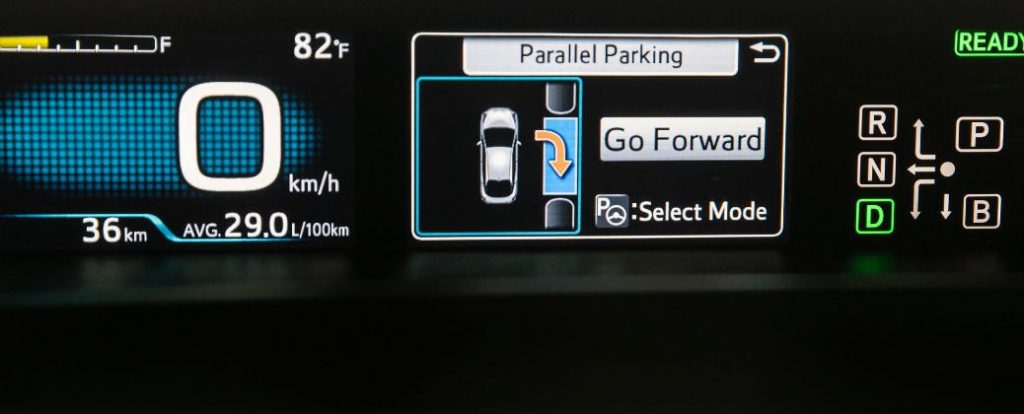
Types of sensors
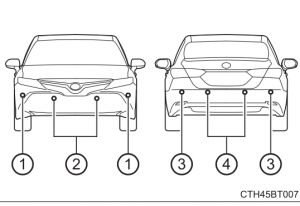
- Front corner sensors
- Front center sensors
- Rear corner sensors
- Rear center sensors
Turning the intuitive parking assist on/off
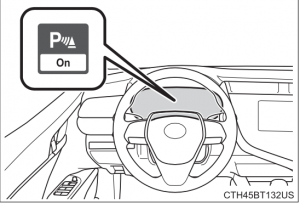
- Press / of the meter control switches, select .
- Press </> of the meter control switches, select P
- Press OK button of the meter control switch.
Each time OK is pressed, the function changes on/off.
When on, the indicator light comes on to inform the driver that the system is operational.
Display
When the sensors detect an object, the following displays inform the driver of the position and distance to the object.
Multi-information display

- Front corner sensor operation
- Front center sensor operation
- Rear corner sensor operation
- Rear center sensor operation
- Select to mute the buzzer sounds.
Audio system screen
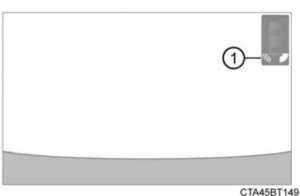
- Intuitive parking assist
When the vehicle is moving backward.
A simplified image is displayed on the upper part of the screen when an object is detected.
Muting the buzzer sound
- To mute the buzzer sound
The buzzer can be temporarily muted by pressing OK of the metter control switches while an object detection display is shown on the multi-information display. - To cancel the mute
Mute will be automatically cancelled in the following situations.- When the shift position is changed
- When the vehicle speed has reached or exceeded approximately 6 mph (10 km/h) with the shift lever in D
- When the intuitive parking assist is turned off once and turned on again
Vehicles without a smart key system: - When the engine switch is turned off once and turned to “ON” position again
Vehicles with a smart key system: - When the engine switch is turned off once and turned to IGNITION ON mode again
- When a sensor is malfunctioning
Sensor detection display, object distance
Distance display
Sensors that detect an object will illuminate continuously or blink.
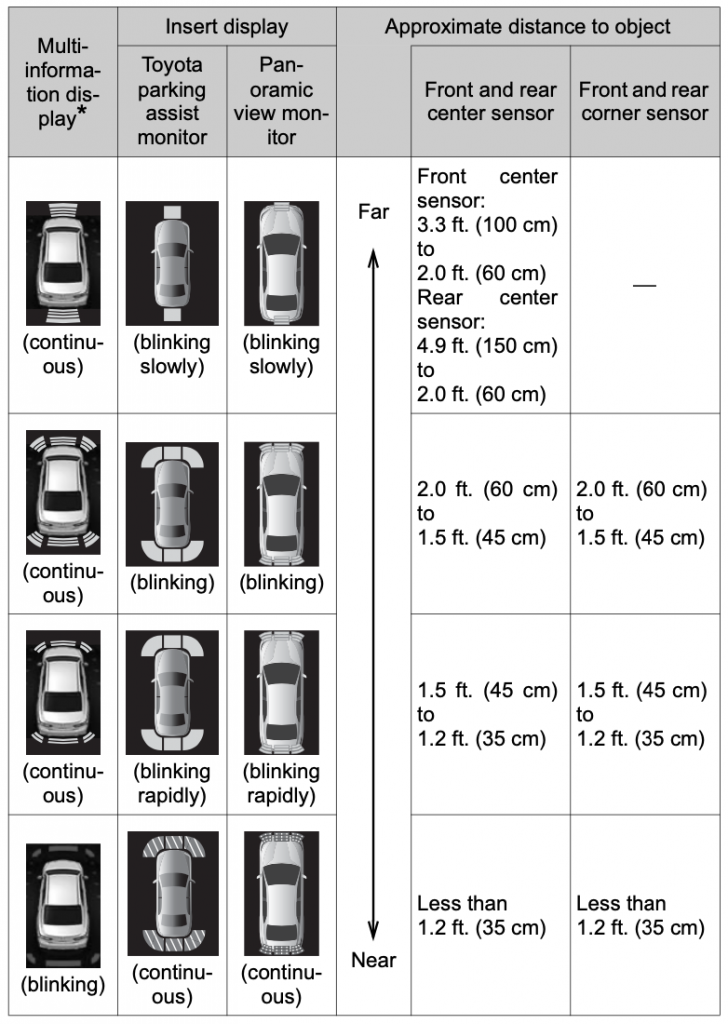
*: The images may differ from those shown in the illustrations.
Buzzer operation and distance to an object
A buzzer sounds when the sensors are operating.
- The buzzer sounds faster as the vehicle approaches an object.
When the vehicle comes within the following distance of the object, the buzzer sounds continuously: Approximately 1.2 ft. (35 cm). - When 2 or more objects are detected simultaneously, the buzzer system responds to the nearest object. If one or both come within the above distances, the beep will repeat a long tone, followed by fast beeps.
Detection range of the sensors
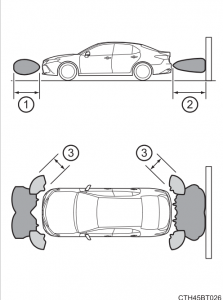
- Approximately 3.3 ft. (100 cm)
- Approximately 4.9 ft. (150 cm)
- Approximately 2.0 ft. (60 cm)
The diagram shows the detection range of the sensors. Note that the sensors cannot detect objects that are extremely close to the vehicle.
The range of the sensors may change depending on the shape of the object, etc.
Changing the buzzer sounds volume
- Vehicles without a smart key system: The buzzer volume can be changed on the multi-information display when the engine switch is in the “ON” position.
- Vehicles with a smart key system: The buzzer volume can be changed on the multi-information display when the engine switch is in the IGNITION ON mode.
The intuitive parking assist can be operated when
- Front corner sensors:
- Vehicles without a smart key system: The engine switch is in the “ON” position.
- Vehicles with a smart key system: The engine switch is in IGNITION ON mode.
- The shift lever is in other than P.
- The vehicle speed is less than about 6 mph (10 km/h).
- Front center sensors:
- Vehicles without a smart key system: The engine switch is in the “ON” position.
- Vehicles with a smart key system: The engine switch is in IGNITION ON mode.
- The shift lever is in other than P or R.
- The vehicle speed is less than about 6 mph (10 km/h).
- Rear corner and rear center sensors:
- Vehicles without a smart key system: The engine switch is in the “ON” position.
- Vehicles with a smart key system: The engine switch is in IGNITION ON mode.
- The shift lever is in R.
- The vehicle speed is less than about 6 mph (10 km/h).
Intuitive parking assist display
When an object is detected while the Toyota parking assist monitor or panoramic view monitor is in use, the warning indicator will appear in the upper part of the screen even if the display setting has been set to off.
Sensor detection information
- The sensor’s detection areas are limited to the areas around the vehicle’s bumper.
- Depending on the shape of the object and other factors, the detection distance may shorten, or detection may be impossible.
- Objects may not be detected if they are too close to the sensor.
- There will be a short delay between object detection and display. Even at slow speeds, there is a possibility that the object will come within the sensor’s detection areas before the display is shown and the buzzer sounds.
- Thin posts or objects lower than the sensor may not be detected when approached, even if they have been detected once.
- It might be difficult to hear beeps due to the volume of audio system or air flow noise of the air conditioning system.
If “Parking Assist Unavailable Clean Parking Assist Sensor” is displayed on the multi information display
A sensor may be dirty or covered with snow or ice. In such cases, if it is removed from the sensor, the system should return to normal.
Also, due to the sensor being frozen at low temperatures, a malfunction display may appear or an object may not be detected. If the sensor thaws out, the system should return to normal.
If “Parking Assist Unavailable” is displayed on the multi-information display
Water may be continuously flowing over the sensor surface, such as in a heavy rain. When the system determines that it is normal, the system will return to normal.
WARNING
When using the intuitive parking assist
Observe the following precautions.
Failing to do so may result in the vehicle being unable to be driven safely and possibly cause an accident.
- Do not use the sensor at speeds in excess of 6 mph (10 km/h).
- The sensors’ detection areas and reaction times are limited. When moving forward or reversing, check the areas surrounding the vehicle (especially the sides of the vehicle) for safety, and drive slowly, using the brake to control the vehicle’s speed.
- Do not install accessories within the sensors’ detection areas.
Sensors
Certain vehicle conditions and the surrounding environment may affect the ability of a sensor to correctly detect an object. Particular instances where this may occur are listed below.
- There is dirt, snow or ice on the sensor. (Wiping the sensors will resolve this problem.)
- The sensor is frozen. (Thawing the area will resolve this problem.)
In especially cold weather, if a sensor is frozen the screen may show an abnormal display, or objects may not be detected. - The sensor is covered in any way.
- The vehicle is leaning considerably to one side.
- On an extremely bumpy road, on an incline, on gravel, or on grass.
- The vicinity of the vehicle is noisy due to vehicle horns, motorcycle engines, air brakes of large vehicles, or other loud noises producing ultrasonic waves.
- There is another vehicle equipped with parking assist sensors in the vicinity.
- The sensor is coated with a sheet of spray or heavy rain.
- The sensor is drenched with water on a flooded road.
- The vehicle is equipped with a fender pole or wireless antenna.
- Towing eyelets are installed.
- The bumper or sensor receives a strong impact.
- The vehicle is approaching a tall or curved curb.
- The detection range is reduced due to an object such as a sign.
- In harsh sunlight or intense cold weather.
- The area directly under the bumpers is not detected.
- If objects draw too close to the sensor.
- A non-genuine Toyota suspension (lowered suspension, etc.) is installed.
- A backlit license plate is installed.
In addition to the examples above, there are instances in which, because of their shape, signs and other objects may be judged by a sensor to be closer than they are.
Objects which may not be properly detected
The shape of the object may prevent a sensor from detecting it. Pay particular attention to the following objects:
- Wires, fences, ropes, etc.
- Cotton, snow and other materials that absorb sound waves
- Sharply-angled objects
- Low objects
- Tall objects with upper sections projecting outwards in the direction of your vehicle
- People may not be detected if they are wearing certain types of clothing.
NOTICE
When using intuitive parking assist
In the following situations, the system may not function correctly due to a sensor malfunction, etc. Have the vehicle checked by your Toyota dealer.
- The intuitive parking assist operation display flashes, and a buzzer sounds when no objects are detected.
- If the area around a sensor collides with something, or is subjected to strong impact.
- If the bumper collides with something.
- If the display shows continuously without beeping, except when the buzzer volume is muted.
- If a display error occurs, first check the sensor.
If the error occurs even if there is no ice, snow or mud on the sensor, it is likely that the sensor is malfunctioning.
Notes when washing the vehicle
Do not apply intensive bursts of water or steam to the sensor area. Doing so may result in the sensor malfunctioning.